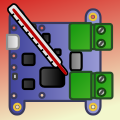Interfacing a SPI magnetic card reader by USB
![]() Someone recently asked us whether there was a Yoctopuce module which could interface an OMRON V3A magnetic stripe card reader over USB. Although nowadays these magnetic strips are not the most secure way to identify someone, they are still present on credit/debit cards for example. So we took an interest in them.
Someone recently asked us whether there was a Yoctopuce module which could interface an OMRON V3A magnetic stripe card reader over USB. Although nowadays these magnetic strips are not the most secure way to identify someone, they are still present on credit/debit cards for example. So we took an interest in them.
| No comment yet | Read more... |
Device tests at very low temperatures
![]() Now that we finally have our small dry ice freezer, we were able to perform systematic measures of cold endurance for our sensors and transmitters. So here are the tests that we performed and the results.
Now that we finally have our small dry ice freezer, we were able to perform systematic measures of cold endurance for our sensors and transmitters. So here are the tests that we performed and the results.
| No comment yet | Read more... |
Temperature tests on Yoctopuce devices
 You may have noticed that until now our module specifications didn't include a working temperature range. This omission could seem strange, but we didn't want to give raw numbers without accompanying them with some explanations. Indeed, although most of the modules were designed for an extended temperature range, we hadn't had the opportunity to formally valid the theoretical temperatures. Thanks to the small system built two weeks ago, it's getting ready.
You may have noticed that until now our module specifications didn't include a working temperature range. This omission could seem strange, but we didn't want to give raw numbers without accompanying them with some explanations. Indeed, although most of the modules were designed for an extended temperature range, we hadn't had the opportunity to formally valid the theoretical temperatures. Thanks to the small system built two weeks ago, it's getting ready.
| No comment yet | Read more... |
How to connect NPN and PNP sensors
From time to time, Yoctopuce support receives questions from customers who do not quite know what to do with the three wires coming out of a PNP or NPN sensor. This week, we are going to tell you how these NPN and PNP outputs work, how to connect them, and with which modules.
| No comment yet | Read more... |
Interfacing a Wiegand RFID reader by USB
![]() Among the requests that we received in the past few weeks, one caught our attention more particularly: how to interface a Wiegand RFID badge reader via USB, using Yoctopuce modules. It's interesting because Wiegand readers are widely spread in access control systems, and they are readily and quite cheaply available on the net. The good news is that we now have a solution, using a simple Yocto-Serial.
Among the requests that we received in the past few weeks, one caught our attention more particularly: how to interface a Wiegand RFID badge reader via USB, using Yoctopuce modules. It's interesting because Wiegand readers are widely spread in access control systems, and they are readily and quite cheaply available on the net. The good news is that we now have a solution, using a simple Yocto-Serial.
| No comment yet | Read more... |


